14 Great Cardiovascular Exercises To Do at Home

Key Takeways
At-home cardio workouts are a convenient way to meet these exercise goals, and they don’t require a costly gym membership or any expensive equipment! Whether you're a beginner or a seasoned fitness enthusiast, these exercises can boost your heart health, burn calories, and even improve your mental health.
In this article, we’ll guide you through 14 best cardio workouts and exercises for any fitness level that you can easily do in the comfort of your own home.
1) Lunge Jumps
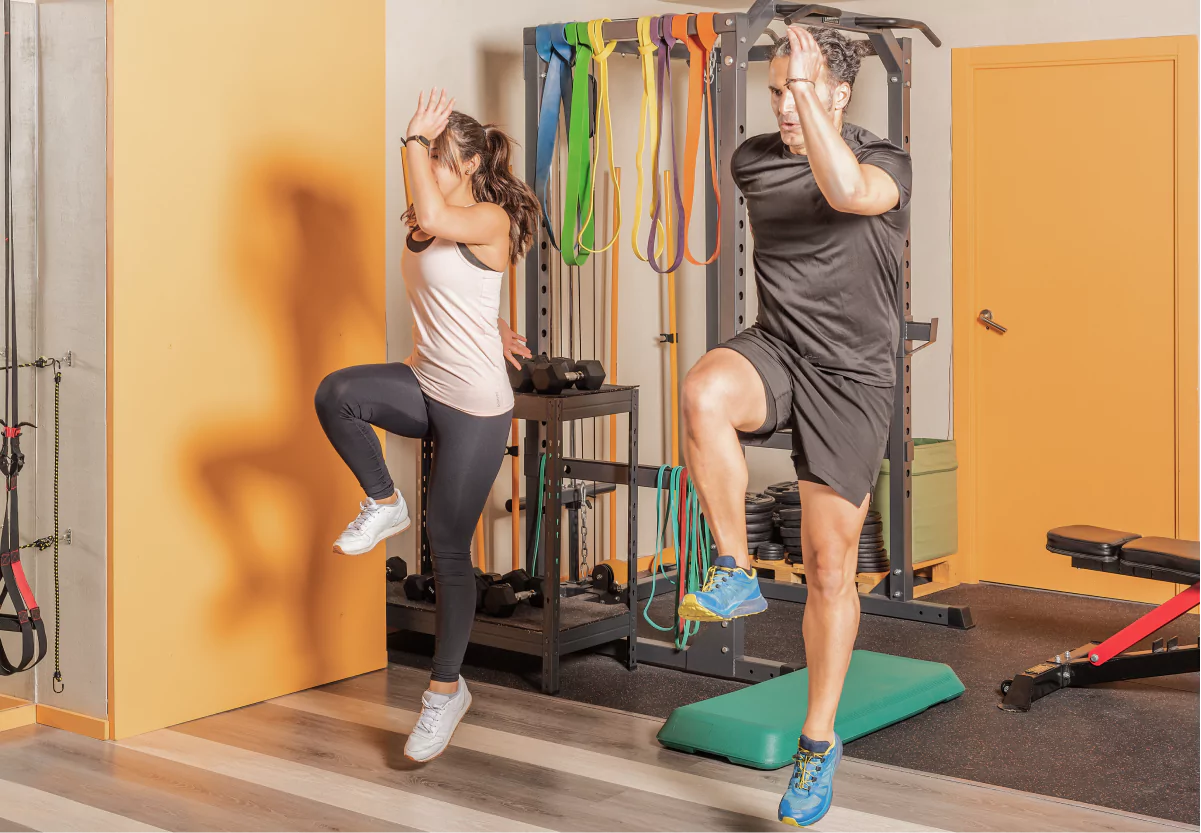
Lunge jumps are a variation of the traditional lunge exercise that adds an explosive element to your aerobic workout routine. This engages multiple muscle groups simultaneously, including your quadriceps, hamstrings, glutes, and calves, providing a comprehensive lower body workout.
To perform a lunge jump:
- Start by standing in a straight posture with your feet hip-width apart.
- Take a step forward with your right foot, ensuring that your right knee is bent at a 90-degree angle and your left knee is lowered towards the ground.
- From the lunge position, propel yourself upwards explosively, pushing off with both feet.
- While in the air, switch your leg positions, bringing your left foot forward and your right foot back.
- Land softly on the ground with your left foot in front and your right foot behind you, and repeat.
2) Jumping Jacks

Jumping jacks are a classic and effective plyometric exercise that can be done virtually anywhere. Jumping jacks elevate your heart rate and engage muscles in your legs, arms, and core, providing a full-body workout.
To perform a jumping jack:
- Stand upright with your legs together and your arms at your sides.
- Bending your knees slightly, jump into the air.
- As you jump, open your legs to shoulder-width and stretch your arms out over your head.
- Land softly and quickly reverse the motion by jumping again and returning to the starting position. Repeat.
3) Mountain Climbers
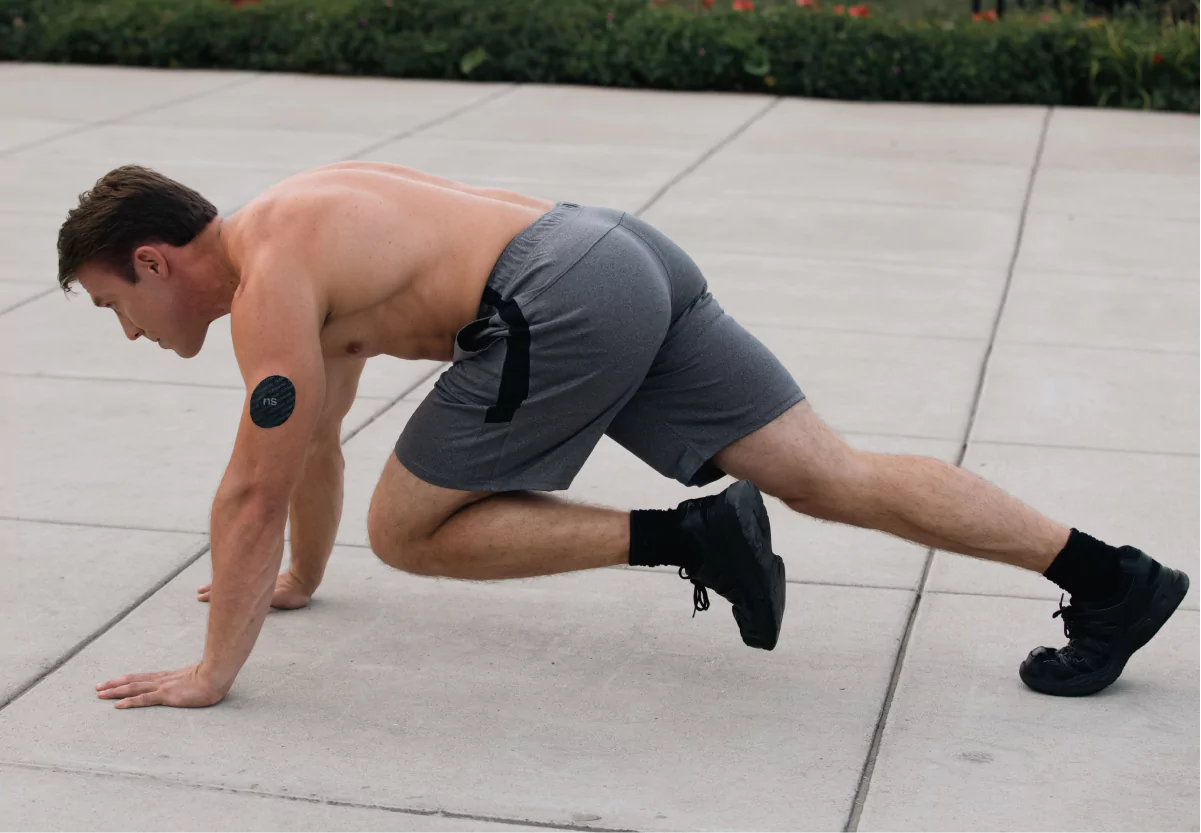
Mountain climbers are an effective cardio exercise that engages your core, upper body, and lower body while elevating your heart rate. They can be incorporated into circuit training, high-intensity interval training (HIIT), or used as a warm-up exercise before engaging in other activities.
To perform mountain climbers:
- Start in a high plank position with your hands shoulder-width apart and your feet hip-width apart.
- Bring your right knee towards your chest, keeping your left leg extended.
- Quickly switch legs, bringing your left knee towards your chest and extending your right leg.
- Continue alternating legs, moving at a fast pace as if you are climbing a mountain.
4) High Knees

High knees are an energizing cardio exercise that targets your lower body while providing an excellent cardiovascular workout. To perform high knees:
- Start with your feet hip-width apart and arms at your sides.
- Lift your right knee up to your chest.
- Quickly lower your knee and repeat with the other knee.
- Repeat, alternate your knees at a quick pace.
5) Toe Taps
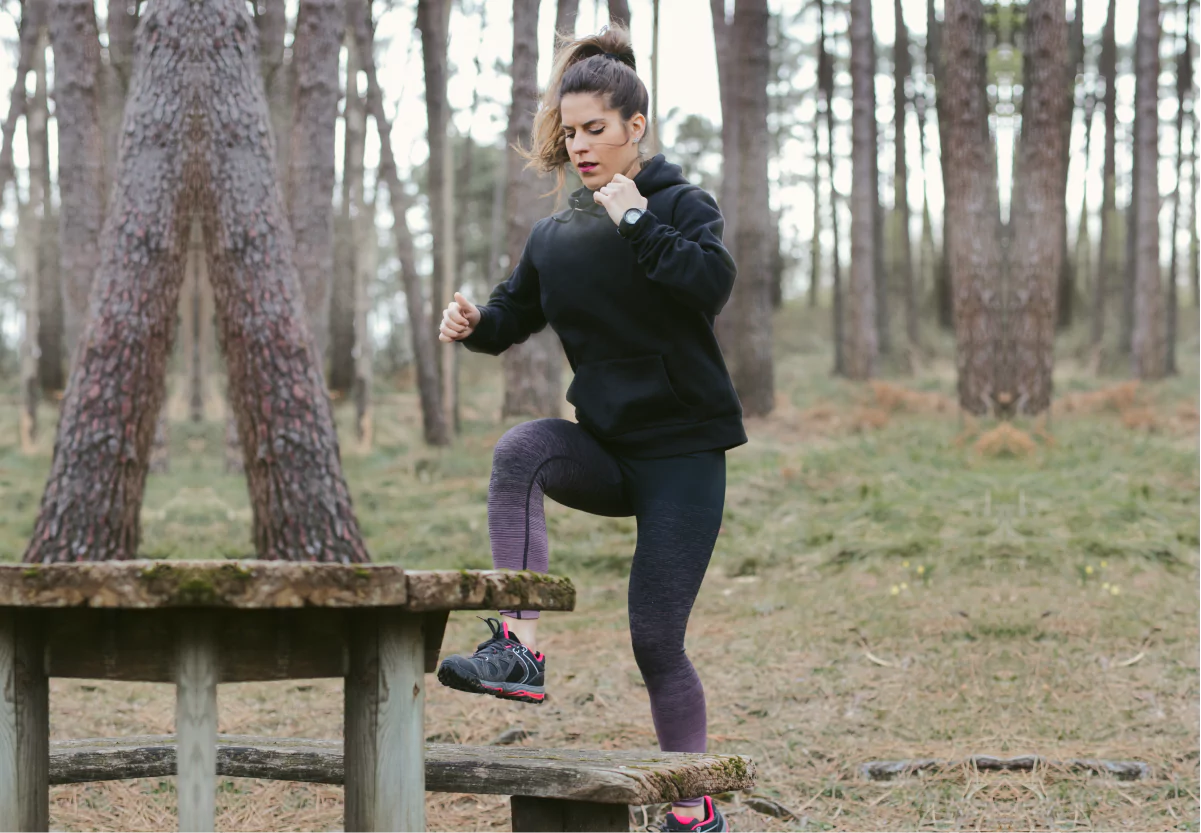
Toe taps are a simple yet effective cardio exercise that targets your lower body and gets your heart rate up. To perform toe taps:
- Stand with your feet together and your arms at your sides, facing a sturdy raised surface, such as a step or bench.
- Lift your right foot and quickly tap the ball of your foot on the raised surface.
- Immediately lift your right foot off the surface and bring it back to the starting position.
- Repeat the same motion with your left foot, tapping the ball of your foot on the raised surface and then returning to the starting position.
6) Squat Jumps

Squat jumps are a plyometric exercise that combines the benefits of squats and explosive jumps, making it a powerful cardiovascular exercise and a great addition to a HIIT workout. To perform squat jumps:
- Stand with your feet shoulder-width apart, toes slightly turned out, and your arms at your sides.
- Lower your body into a squat position by bending your knees and pushing your hips back as if you were sitting down.
- As you reach the bottom of the squat, explode upward forcefully, extending your legs and propelling yourself off the ground. While in the air, swing your arms upward for momentum and balance.
- Land softly back into the squat position, focusing on bending your knees to absorb the impact and repeat.
7) Burpees

Burpees are a challenging, high-intensity exercise that combines targets the entire body and uses multiple movements, including a squat, plank, push-up, and jump. To perform burpees:
- Begin with your knees bent in a squat position with your back straight and your feet shoulder-width apart
- Place your hands on the floor between your feet
- Kick your legs back into a plank position, with your body in a straight line from shoulders to heels
- Bend your elbows and do a pushup, bringing your body toward the floor
- Rise back into plank and jump your legs forward back into the starting squat position
- From the squat position, jump into the air with your hands above your head
- Land from the jump with your knees bent, and return to the squat position and restart the process
8) Box Jumps

The explosive movement involved in box jumps engages these lower body muscles and your cardiovascular system, making it an excellent cardio exercise. To perform box jumps:
- Start by standing facing the box, with your feet shoulder-width apart.
- Lower your body into a quarter squat position while bending your knees.
- Swing your arms back for momentum, then immediately swing them forward as you forcefully push through your legs and jump up.
- Tuck your knees towards your chest and land softly on top of the box, focusing on landing on the balls of your feet.
- Step or jump back down to the starting position, ensuring a controlled landing with a slight bend in your knees.
9) Jump Rope

Jumping rope is a classic and effective cardio exercise that can be done virtually anywhere and requires minimal equipment. The rhythmic and coordinated movement of jumping rope can also help improve your coordination, timing, and agility.
To try jumping rope:
- Begin in an open area with enough space overhead to accommodate the swinging rope.
- Hold the handles of a jump rope, one in each hand, with your palms facing towards your body. Allow the rope to hang behind you, touching the ground.
- Swing the rope forward with your wrists, and jump up with both feet together, as the rope passes under your feet.
- Land softly on the balls of your feet, keeping your knees slightly bent to absorb the impact.
- As soon as you land, immediately jump again, and repeat.
10) Jogging in Place
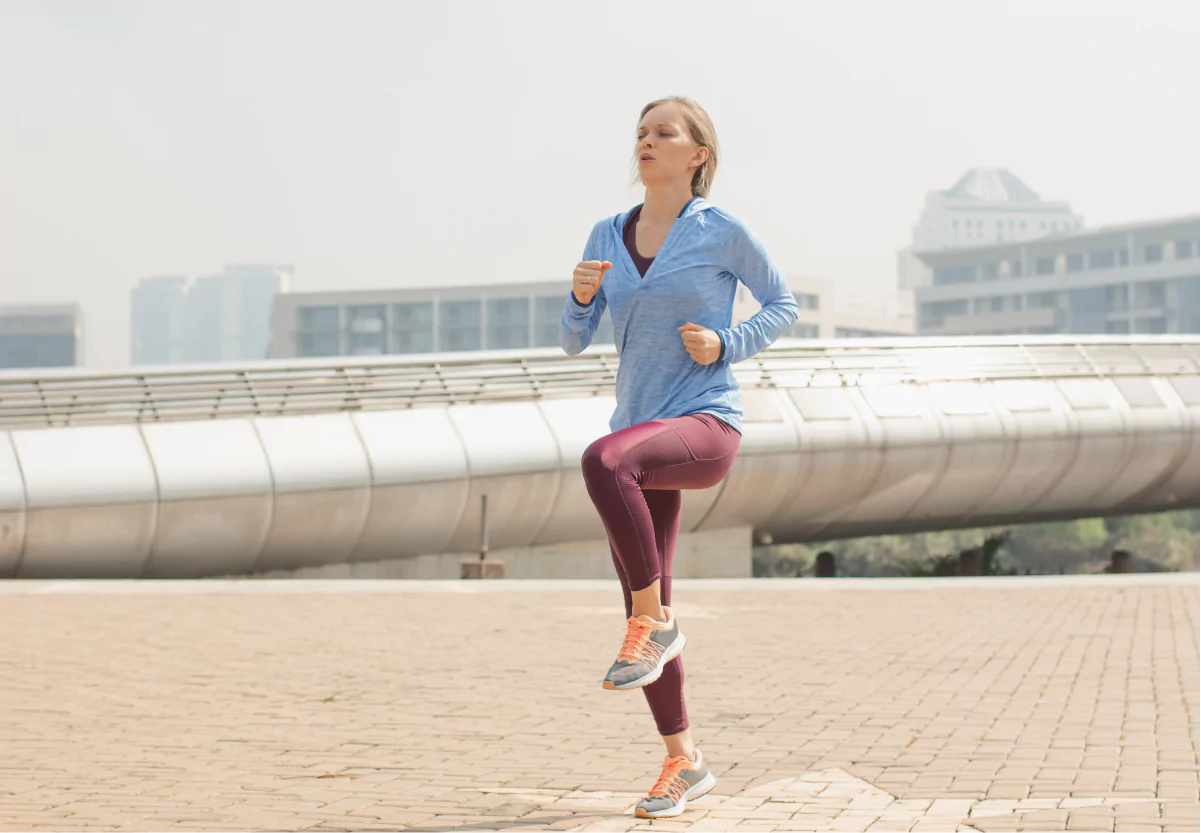
Jogging in place is a simple and effective cardio exercise that gets your heart pumping and replicates the motion of jogging or running, but without the need for a large outdoor space or a treadmill. To try jogging in place:
- Start by lifting your right foot slightly off the ground and bring your knee up towards your chest, followed by your left foot.
- Swing your arms naturally back and forth, opposite to the movement of your legs, to enhance the rhythm and coordination.
- Continue this alternating motion, and maintain a steady pace that is comfortable for you.
11) Speed Skaters

Speed skaters are a dynamic and high-intensity cardio exercise that mimics the movements of a speed skater on the ice. Lateral exercises like speed skaters have been shown to increase agility and stability.
To perform speed skaters:
- Start by standing upright with your feet shoulder-width apart.
- Take a lateral leap to the right, shifting your body weight onto your right leg.
- As you land on your right leg, bend your right knee and extend your left leg diagonally behind your body.
- Repeat on the opposite side, pushing off forcefully with your right leg and leaping laterally to the left, shifting your body weight onto your left leg and extending your right leg diagonally behind your body
- Continue this lateral jumping motion, alternating sides with each leap, resembling the movement of a speed skater.
12) Plank Jacks

Plank jacks are a cardio exercise that combines the core-strengthening benefits of the plank with the cardiovascular intensity of jumping jacks. To perform plank jacks:
- Start in a high plank position with your hands directly under your shoulders and your body forming a straight line from head to heels.
- From the plank position, jump both feet wide apart, similar to the motion of a jumping jack, keeping your arms and upper body stationary.
- Quickly jump your feet back together, returning to the starting plank position.
- Continue the jumping motion, alternating between feet wide and feet together, while maintaining a strong plank position.
13) Lateral Shuffles
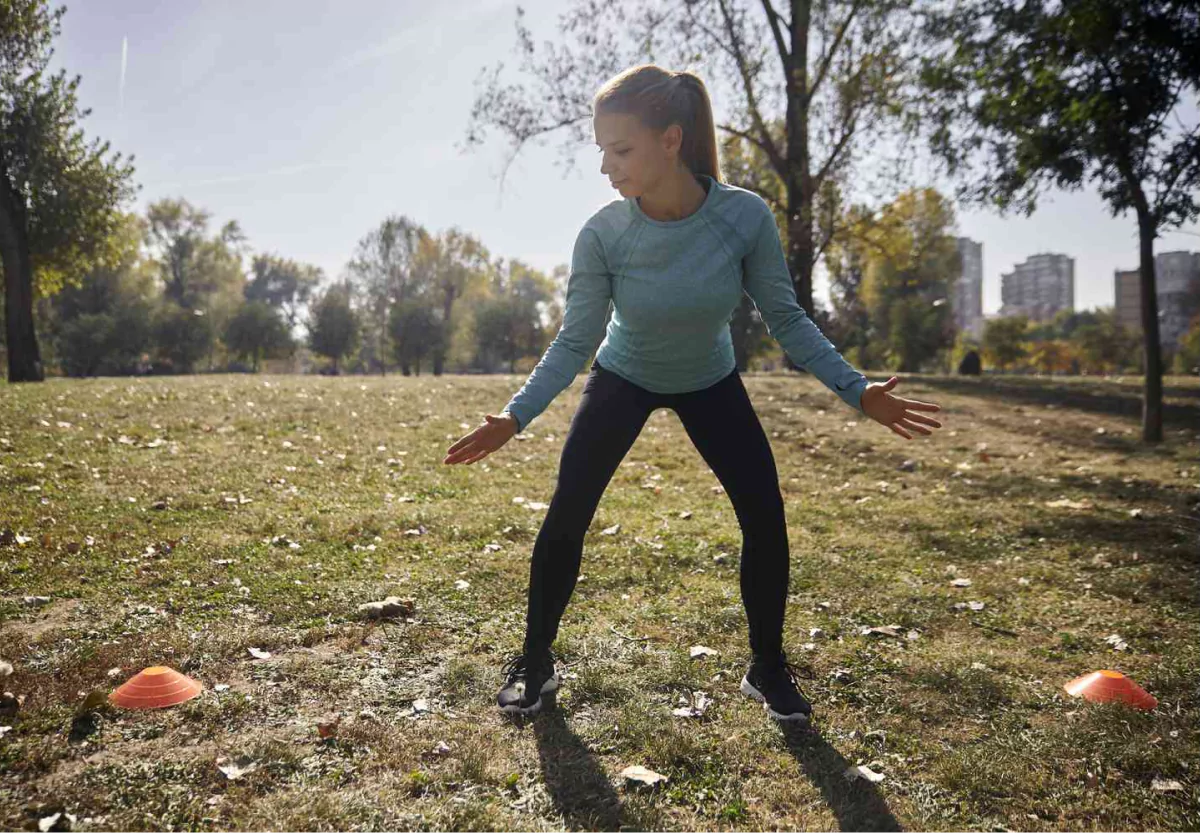
Lateral shuffles are a cardio exercise that involves moving sideways in a quick and controlled manner. This movement primarily targets the lower body muscles, especially the inner and outer thighs.
To perform lateral shuffles:
- Start in a low squat position with your feet slightly wider than hip-width apart and your knees bent.
- Step to the side with your right foot and quickly shuffle your left foot to the side, followed by your right foot, maintaining the low squat position throughout.
- Repeat, leading with the left foot and going the opposite direction. Continue shuffling laterally, alternating the lead foot with each shuffle.
14) Tuck Jumps

Tuck jumps are an explosive plyometric exercise that combines a vertical jump with a tucked knee position in mid-air. To perform tuck jumps:
- Start in a standing position with your feet hip-width apart and arms by your sides.
- Bend your knees and jump explosively upward, driving your arms upward for momentum.
- As you reach the peak of your jump, bring your knees up toward your chest, tucking them in as tightly as you can.
- Land softly with your knees slightly bent, absorbing the impact through your leg muscles.
- Immediately go into the next tuck jump by springing back up into the air from the landing position.
5 Tips for Getting the Most Out of Your Home Workouts

To help you get the most out of your at-home workouts, here are some valuable tips and strategies to keep in mind:
Have a Dedicated Workout Space
When working out at home, it’s important to create a physical distinction between your workout area and other spaces in your home. This separation can enhance motivation and help you establish a consistent workout routine free of distractions.
Make Sure You Are Fueling Properly
Fueling properly for workouts and maintaining proper nutrition is extremely important, especially for aerobic exercise. Consuming a balanced diet that includes carbohydrates, fats, and protein, which provides the amino acids necessary to build and repair muscle, is crucial.
Adequate nutrition supports injury prevention and helps with post-workout recovery. Consult with a healthcare professional or registered dietitian for personalized guidance based on your specific nutritional needs, fitness goals, and any underlying health conditions.
Track Your Blood Glucose Levels
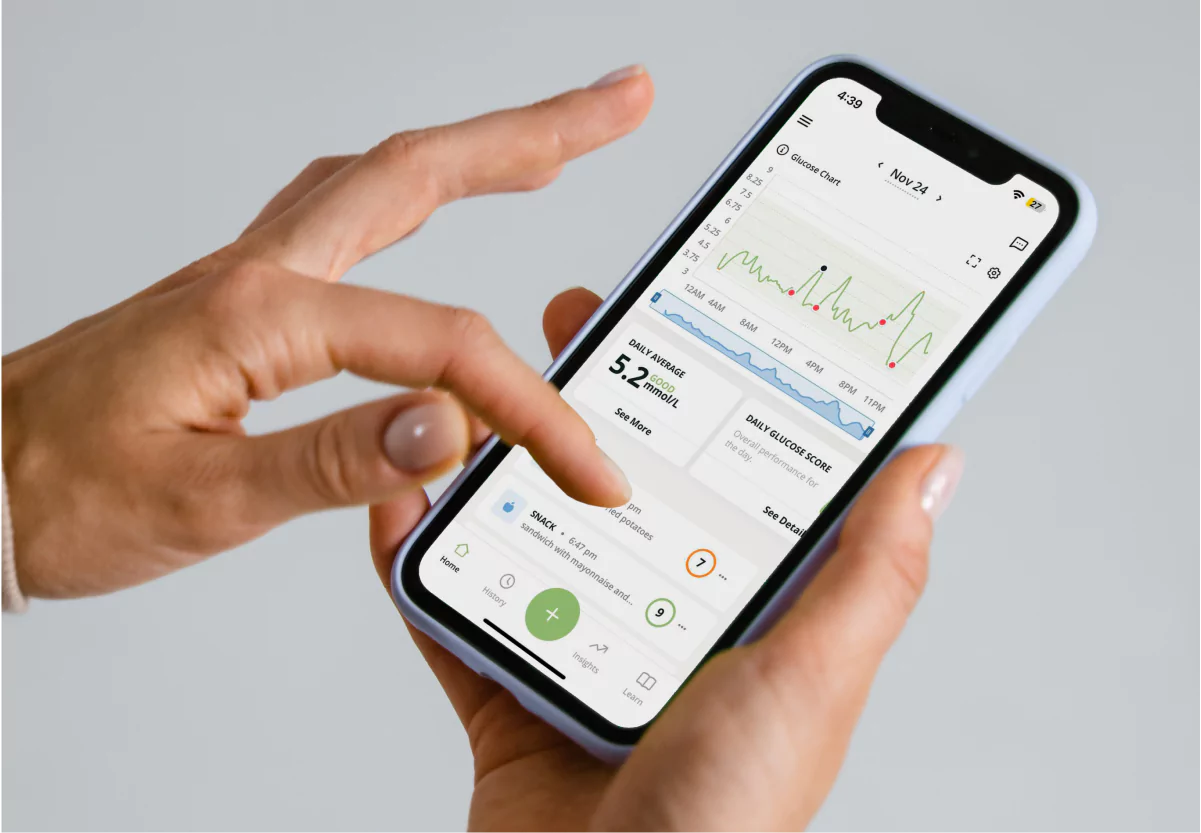
Tracking blood glucose levels with a continuous glucose monitor (CGM) during home workouts allows you to monitor your blood glucose levels in real-time, giving you insights into how your body responds to exercise and the impact it has on your blood sugar.
If you’re interested in using a CGM for home workouts, Nutrisense is here to help! Our CGM program can help you closely monitor your glucose levels, giving you the tools you need to understand how your glucose levels fluctuate, as well as information you can use to fine-tune your workouts and adjust your fueling and nutrition strategies.
Warm Up and Cool Down
Warming up and cooling down before and after workouts are essential components of a safe and effective exercise routine. Warming up helps prepare your body for cardio exercise by gradually raising your body temperature and increasing blood flow to your muscles.
Similarly, cooling down with a short jog or stretching after your workouts allows your body to gradually and safely return to its resting state. Warming up and cooling down properly can also help prevent injury.
Hydrate, Hydrate, Hydrate!
Staying properly hydrated is crucial for optimal performance and safety during workouts. Adequate hydration improves physical performance, helps your body offset sweat loss, and helps maintain optimal brain function during exercise.
The exact amount of fluid intake varies depending on your workout intensity, duration, environmental conditions, and individual needs. Listen to your body's thirst signals and consult with a healthcare professional or sports nutritionist for personalized hydration recommendations.
Find the right Nutrisense programto turn insight into progress.
Go Beyond Glucose Data with Nutrisense
Your glucose can significantly impact how your body feels and functions. That’s why stable levels are an important factor in supporting overall wellbeing. But viewing glucose isn't enough. Nutrisense, you’ll be able to learn how to use your body's data to make informed lifestyle choices that support healthy living.
One-to-one coaching
Sign up to access insurance-covered video calls to work with a glucose expert: a personal registered dietitian or certified nutritionist who will help tailor your lifestyle and diet to your goals.
Monitor and measure what matters
With the Nutrisense CGM Program, you can monitor your glucose with health tech like glucose biosensors and continuous glucose monitor (CGM)s, and analyze the trends over time with the Nutrisense App. This will help you make the most informed choices about the foods you consume and their impact on your health.
Find your best fit
Ready to take the first step? Start with our quiz to find the right Nutrisense program to help you take control.

Heather is a Registered and Licensed Dietitian Nutritionist (RDN, LDN), subject matter expert, and technical writer, with a master's degree in nutrition science from Bastyr University. She has a specialty in neuroendocrinology and has been working in the field of nutrition—including nutrition research, education, medical writing, and clinical integrative and functional nutrition—for over 15 years.




